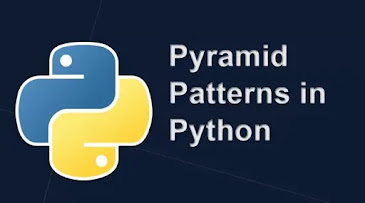Printing Different Pyramid Patterns in Python
 |
We will show some of the star pyramid patterns in this article
Simple Pyramid
def pyra(n):
# outer loop for rows
# n in this case
for i in range(0, n):
# inner loop for columns
for j in range(0, i+1):
# print stars
print("* ",end="")
print("\r")
n = 5
pyra(n)
Output:
*
* *
* * *
* * * *
* * * * *
There is Another Approach:
Here we can print the pyramid pattern with the help of list
def pyra(n):
myList = []
for i in range(1,n+1):
myList.append("*"*i)
print("\n".join(myList))
n = 5
pyra(n)
Output:
*
**
***
****
*****
Now lets see the same pattern After 180 degree rotation
def pyra2(n):
# spaces
k = 2*n - 2
# outer loop to handle number of rows
for i in range(0, n):
# in ner loop for space
for j in range(0, k):
print(end=" ")
k = k - 2
# inner loop for columns
for j in range(0, i+1):
# print stars
print("* ", end="")
print("\r")
n = 5
pyra2(n)
Output:
*
* *
* * *
* * * *
* * * * *
Printing an Triangle:
def triangle(n):
k = 2*n - 2
# outer loop for rows
for i in range(0, n):
# inner loop for spaces
for i in range(0, k):
print(end=" ")
k = k - 1
# inner loop for columns
for j in range(0, i+1):
# print stars
print("* ", end="")
print("\r")
n = 5
triangle(n)
Output:
*
* *
* * *
* * * *
* * * * *
Number pattern :
def numpat(n):
# initialising starting number
num = 1
#outer loop for rows
for i in range(0, n):
# re assigning num
num = 1
# inner loop for columns
for j in range(0, i+1):
print(num, end=" ")
num = num + 1
print("\r")
n = 5
numpat(n)
Output:
1
1 2
1 2 3
1 2 3 4
1 2 3 4 5
Number without re-assingning:
def contnum(n):
# initializing starting number
num = 1
# outer loop for rows
for i in range(0, n):
# not re assigning num
# num = 1
# inner loop for columns
for j in range(0, i+1):
#print number
print(num, end=" ")
num = num + 1
print("\r")
n = 5
contnum(n)
Output:
1
2 3
4 5 6
7 8 9 10
11 12 13 14 15
Character Pattern:
def alphpat(n):
# initializing value corresponding to 'A'
# ASCII value
num = 65
# outer loop for rows
# 5 in this case
for i in range(0, n):
# inner loop for columns
for j in range(0, i+1):
# explicitely converting to char
ch = chr(num)
# printing char value
print(ch, end=" ")
num = num + 1
print("\r")
n = 5
alphpat(n)
Output:
A
B B
C C C
D D D D
E E E E E
Continuous Character pattern:
def contalpha(n):
# initializing value corresponding to 'A'
# ASCII value
num = 65
# outer loop for rows
for i in range(0, n):
# inner loop for column
for j in range(0, i+1):
# explicitely converting to char
ch = chr(num)
# print value
print(ch, end=" ")
num = num +1
print("\r")
n = 5
contalpha(n)
Output:
A
B C
D E F
G H I J
K L M N O
also see:
- Any and All in Python
- Inplace and Standard operator in python
- Python a += b is not always a = a + b
- Difference between == and is operator
- Python Membership and Identity Operators








0 Comments
If you have any doubt, Please let me know.